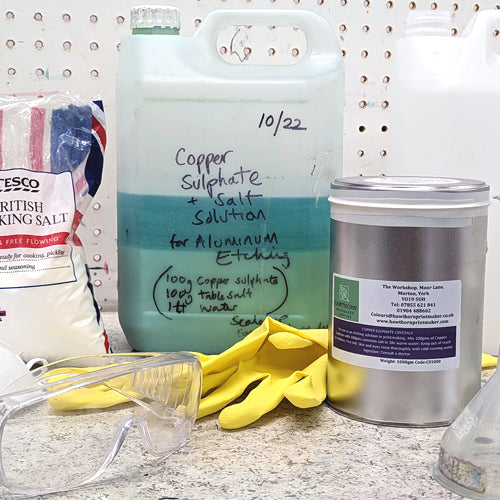Making a Copper Sulphate Mordant Solution

Copper sulphate is a non-toxic mordant used to etch aluminium, zinc and steel plates for intaglio printmaking. Copper sulphate is a safer alternative to acids - and we always opt for safer solutions here at the Handprinted studio!
Metal plates are traditionally etched using highly corrosive acids, which generate noxious gases and can cause burns if they touch your skin. Acids also require specific equipment to mix and store safely.
Thanks to copper sulphate, etching has become much safer and more accessible – you can even mix and store this solution at home!
This blog will be the first of a series featuring tips and techniques to get you started with aluminium or zinc plate etching. First, let’s learn how to mix your own copper sulphate solution.
How to mix your copper sulphate solution:
Even though copper sulphate is non-toxic, you should wear a mouth covering, eye protection and gloves when handling the copper sulphate crystals. Ventilate your area too.

Using your measuring jug, fill your plastic container with 1 litre of warm water.

Using your measuring scales, weigh out 100g of table salt. Add the measured salt to the warm water in your plastic container using a funnel. Gently agitate to allow the salt to dissolve.

Using your measuring scales, weigh out 100g of copper sulphate crystals. Take care not to breathe in any dust from the crystals. Replace the lid back on your tin of copper sulphate crystals and put it away. Carefully add the measured copper sulphate crystals to the warm water using a funnel.

Place the lid firmly on your plastic container and shake it until the blue crystals fully dissolve. Your solution will turn milky turquoise in colour.

Using a waterproof marker, write on the date the solution was made. You can also add the recipe (eg: 100g Copper Sulphate, 100g Salt, 1 Litre Water).

Other tips
- If the solution has been standing still, separation is normal. Just shake it up before using.
- Your solution can be stored safely in the plastic container, but keep it out of reach from children, pets and from direct sunlight.
- Once your solution is made, it’s good practice to test the strength of the solution before you etch your plates.
- If you need more solution than 1 litre, you can scale up this recipe. Eg. 3 litres of water to 300g Copper Sulphate Crystals and 300g of Table Salt. We find 1 litre is enough to fill a standard tray.
- If you find your solution is becoming weaker with use, you can rejuvenate your solution by adding 100g of Copper Sulphate Crystals, 100g of Table Salt and ½ a litre of warm water.
- If you would like to dispose of the solution, leave it in a tray (where it won't be disturbed) and allow the water to evaporate over time. The powder that is left behind in the tray can be disposed of in your normal bin.
- This solution cannot be used with copper plates: it can only be used with aluminium, zinc and steel plates.
For this project, you will need:
- Copper Sulphate Crystals
- Table Salt
- Warm Water
- A clean plastic storage container, sealable and watertight - such as a jerry can
- Measuring scales
- A non-food container (for holding measurements)
- Measuring jug
- Funnel
- Waterproof marker or Sharpie pen
